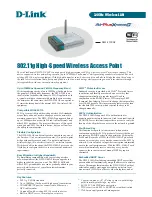
32
RTS Threshold
The RTS threshold determines the packet size at which the radio issues a
request to send (RTS) before sending the packet. A low RTS Threshold setting
can be useful in areas where many client devices are associating with the
device, or in areas where the clients are far apart and can detect only the
device and not each other. You can enter a setting ranging from 0 to 2347
bytes.
Beacon Interval
The beacon interval is the amount of time between access point beacons in
mini-seconds. The default beacon interval is 100.
ACK Timing
Acknowledgement Timing, is the amount of time that device wait client’s
response. This concept is related to EIFS (Extended Inter-Frame Space).
The EIFS interval shall begin while the device is idle after detection of the
erroneous frame. The EIFS is defined to provide enough time for another
device to acknowledge what was, to this device, an incorrectly received
frame before this device commences transmission. The default setting of
ACK timing is 0. You may need to change this value due to the environment
or distance.
Client Expired Time
The client expired time determines time interval the client need to re-associate
with the device while client is idle. The default client expired time is 300 sec.
MTU Size
Maximum Transmission Unit, the default MTU size is 1500. The MTU setting
controls the maximum Ethernet packet size your PC will send. Why a limit?
Because although larger packets can be constructed and sent, your ISP and
Internet backbone routers and equipment will fragment any larger than their
limit, then these parts are re-assembled by the target equipment before
reading. This fragmentation and re-assembly is not optimal. You may need to
change the MTU for optimal performance of your wireless LAN traffic.
Data Rate
The standard IEEE 802.11b/11g supports 1, 2, 5.5, 11 / 6, 9, 12, 18, 24, 36, 48
and 54 Mbps data rates. You can choose the rate that the device uses for data
transmission. The default value is “auto”. The device will use the highest
possible selected transmission rate.
Broadcast SSID
Broadcasting the SSID will let your wireless clients find the device
automatically. If you are building a public Wireless Network, disable this
function can provide better security. Every wireless stations located within the
coverage of the device must connect this device by manually configure the








































